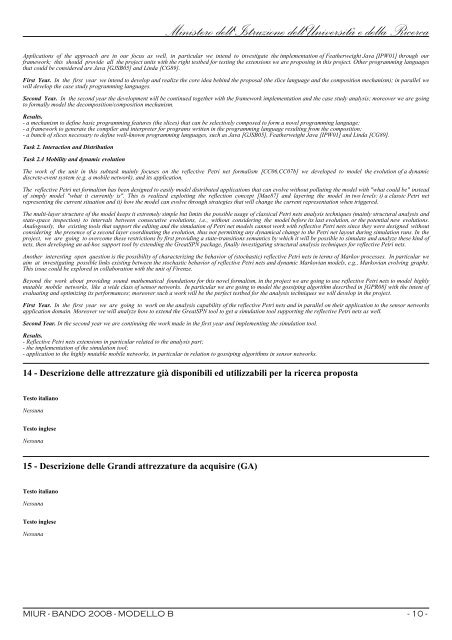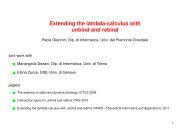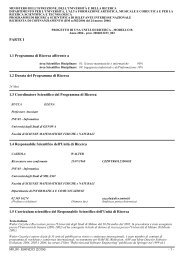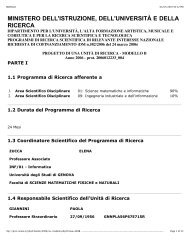Modello B - Università degli Studi di Genova
Modello B - Università degli Studi di Genova
Modello B - Università degli Studi di Genova
You also want an ePaper? Increase the reach of your titles
YUMPU automatically turns print PDFs into web optimized ePapers that Google loves.
Ministero dell'Istruzione dell'<strong>Università</strong> e della Ricerca<br />
Applications of the approach are in our focus as well, in particular we intend to investigate the implementation of Featherweight Java [IPW01] through our<br />
framework; this should provide all the project units with the right testbed for testing the extensions we are proposing in this project. Other programming languages<br />
that could be considered are Java [GJSB05] and Linda [CG89].<br />
First Year. In the first year we intend to develop and realize the core idea behind the proposal (the slice language and the composition mechanism); in parallel we<br />
will develop the case study programming languages.<br />
Second Year. In the second year the development will be continued together with the framework implementation and the case study analysis; moreover we are going<br />
to formally model the decomposition/composition mechanism.<br />
Results.<br />
- a mechanism to define basic programming features (the slices) that can be selectively composed to form a novel programming language;<br />
- a framework to generate the compiler and interpreter for programs written in the programming language resulting from the composition;<br />
- a bunch of slices necessary to define well-known programming languages, such as Java [GJSB05], Featherweight Java [IPW01] and Linda [CG89].<br />
Task 2. Interaction and Distribution<br />
Task 2.4 Mobility and dynamic evolution<br />
The work of the unit in this subtask mainly focuses on the reflective Petri net formalism [CC06,CC07b] we developed to model the evolution of a dynamic<br />
<strong>di</strong>screte-event system (e.g. a mobile network), and its application.<br />
The reflective Petri net formalism has been designed to easily model <strong>di</strong>stributed applications that can evolve without polluting the model with "what could be" instead<br />
of simply model "what it currently is". This is realized exploiting the reflection concept [Mae87] and layering the model in two levels: i) a classic Petri net<br />
representing the current situation and ii) how the model can evolve through strategies that will change the current representation when triggered.<br />
The multi-layer structure of the model keeps it extremely simple but limits the possible usage of classical Petri nets analysis techniques (mainly structural analysis and<br />
state-space inspection) to intervals between consecutive evolutions, i.e., without considering the model before its last evolution, or the potential new evolutions.<br />
Analogously, the existing tools that support the e<strong>di</strong>ting and the simulation of Petri net models cannot work with reflective Petri nets since they were designed without<br />
considering the presence of a second layer coor<strong>di</strong>nating the evolution, thus not permitting any dynamical change to the Petri net layout during simulation runs. In the<br />
project, we are going to overcome these restrictions by first provi<strong>di</strong>ng a state-transitions semantics by which it will be possible to simulate and analyze these kind of<br />
nets, then developing an ad-hoc support tool by exten<strong>di</strong>ng the GreatSPN package, finally investigating structural analysis techniques for reflective Petri nets.<br />
Another interesting open question is the possibility of characterizing the behavior of (stochastic) reflective Petri nets in terms of Markov processes. In particular we<br />
aim at investigating possible links existing between the stochastic behavior of reflective Petri nets and dynamic Markovian models, e.g., Markovian evolving graphs.<br />
This issue could be explored in collaboration with the unit of Firenze.<br />
Beyond the work about provi<strong>di</strong>ng sound mathematical foundations for this novel formalism, in the project we are going to use reflective Petri nets to model highly<br />
mutable mobile networks, like a wide class of sensor networks. In particular we are going to model the gossiping algorithm described in [GPR08] with the intent of<br />
evaluating and optimizing its performances; moreover such a work will be the perfect testbed for the analysis techniques we will develop in the project.<br />
First Year. In the first year we are going to work on the analysis capability of the reflective Petri nets and in parallel on their application to the sensor networks<br />
application domain. Moreover we will analyze how to extend the GreatSPN tool to get a simulation tool supporting the reflective Petri nets as well.<br />
Second Year. In the second year we are continuing the work made in the first year and implementing the simulation tool.<br />
Results.<br />
- Reflective Petri nets extensions in particular related to the analysis part;<br />
- the implementation of the simulation tool;<br />
- application to the highly mutable mobile networks, in particular in relation to gossiping algorithms in sensor networks.<br />
14 - Descrizione delle attrezzature già <strong>di</strong>sponibili ed utilizzabili per la ricerca proposta<br />
Testo italiano<br />
Nessuna<br />
Testo inglese<br />
Nessuna<br />
15 - Descrizione delle Gran<strong>di</strong> attrezzature da acquisire (GA)<br />
Testo italiano<br />
Nessuna<br />
Testo inglese<br />
Nessuna<br />
MIUR - BANDO 2008 - MODELLO B - 10 -








